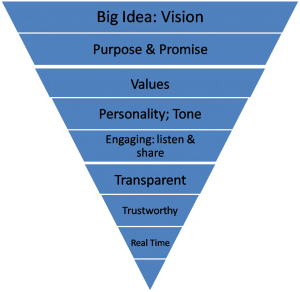A Model For Aligning Business Strategy & Communication, Marketing
Communication Simplification & Business Alignment Model
Yesterday I talked about how clear communications are most powerful and outlined my process of clarification and simplification in communication and marketing.
The problem is when a gap exists between communication/marketing and operations. This usually reflects reality; the existence of a gap between what we’re promising and what we deliver.
Ultimately we’re all in this together. Whether you are a social venture or a for profit company the goal is to add value through innovative solutions you provide and to clearly communicate and powerfully engage your stakeholders, tribe and community.
So communications/marketing must be steeped in reality and advocates of a whole, transparent, highly collaborative team not just an independent, silo. The real job for all of us is to align the business strategy, the social enterprise’s purpose, goals and intentions with stakeholder experience and use all of our communication talents and tools to support the process.
On this note I thought it might be helpful if I shared how I align business or social venture strategy, communication strategy with REALITY.
As a marketer I am an interdependent piece of a collective, collaborative whole that is the tribe, community or business I am apart of. I must have an innate sense of how each of the stakeholders who are involved in the venture feel, think and how I might best engage and serve them.
Here’s a model, a process that brings integrity, simplicity and clarity to your marketing and communications while simultaneously aligning your business or social venture strategy. Remember ultimately it’s about adding value. And as I’ve said before value is in the eyes of the receiver…
1. What is the value added: What is the business strategy, model? What is the value and innovation we provide? Clearly and concisely what is the brand promise and differentiators and are we executing them? How do we know?
2. What is our story: What are we saying about ourselves, what’s our story? If we aren’t sure it’s time to review the story we have ‘out’ there.
4. Market Reality? If we were to compare ourselves against each of our competitors and the alternative ways clients get the benefits we provide, what is reality? Are we different? How so? What is reality in terms of other comparable marketplace offerings? If our competitive elements are clearly innovative and of high value we move to the next question. If not, it’s time to revisit our business or social venture strategy and rethink what needs to happen to bring true innovation and value to stakeholders, clients.
5. Internal Stakeholders Perspective: what is our employee’s experience, what is their take on who we are, the value we provide and how aligned is our story with their reality? If their perspective is different than what we are communicating, believe or intend for our business; we have a gap. Is it a gap in communication? Understanding? Or is it a business execution or strategy gap?
6. External Stakeholders Perspective: What is our clients experience? What is their perception of us, who we are? Do they see gaps between what we say and what we do? How do they define us? What is their perspective?
7. Identify Experience and Communication Gaps: The gaps between business execution, social venture execution and business communication. The difference between what the market, our internal and external stakeholder perceive and what we intend them to experience. The gaps between what we believe about ourselves and the market reality. Gaps.
8. Alignment Time: Now it’s time to go through the ‘gap’ list and decide how, when and why we want to improve our business or social venture. This is where we get better, we don’t merely spin a different story or hum a new tune. We add value, re-invent processes, optimize, simplify, clarify, change and create. The goal is congruency between our business strategy, vision stakeholders experience and our communication and marketing efforts. Congruency drives engagement and engagement drives success.
9. 24/7 Engagement Processes: Engagement processes allow for both listening and sharing to take place with all stakeholders, tribe members. Social tools to allow our team and clients to stay in 24/7 communication if they so choose. Tools to allow us to know and be known to one another. Tools of authenticity, transparency to engage with one another. Listen. Share. Engage heads, hearts and hands.
Okay ideas- how can you plus this?
Pam Hoelzle


Comments are closed.